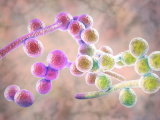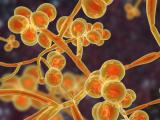Scientists from the Centers for Disease Control and Prevention (CDC) and the New York State Department of Health reported today that three cases of pan-resistant Candida auris have been identified in New York.
The three patients were treated at separate hospitals in New York City, which has the most confirmed C auris cases in the country, at 427. Samples from the three patients were resistant to all three classes of commonly prescribed antifungal drugs—flucanazole, amphotericin B, and echinocandins. Subsequent investigations found no transmission of pan-resistant C auris to other patients or the environment.
C auris is a fungus that was first identified in Japan in 2009, and first appeared in the United States in 2016. It's often resistant to more than one antifungal medication and causes severe invasive infections in hospitalized patients, with associated mortality rates of higher than 30%. Hospitals in more than 30 countries have reported multiple cases, with several reporting outbreaks.
Although the overall number of cases in the United States is small, public health officials have expressed concern about C auris because of the limited treatment options for infected patients, high mortality rates, and the ability of the pathogen to spread easily in healthcare settings.
Resistance emerged after treatment
According to the investigation, which appeared in the CDC's Morbidity and Mortality Weekly Report (MMWR), the pan-resistant isolates were detected during susceptibility testing conducted on two sets of C auris isolates obtained from 801 colonized and infected patients in New York from June 2016 through August 2019.
Those tests revealed that more than 99% of the isolates were resistant to fluconazole, nearly two-thirds were resistant amphotericin B, and roughly 4% were resistant to echinocandins.
Subsequent testing on Three patients' isolates showed they were resistant to all three. The three patients had multiple comorbidities and no known recent foreign or domestic travel.
The first two patients had developed C auris in 2017 and 2018 and were residents of different long-term care facilities in the same New York borough. The third patient was diagnosed in 2017 and had prolonged stays in a hospital and long-term care facility in a separate borough. There were no epidemiologic links between the three.
All of the patients died, with one dying from underlying medical conditions. The role of C auris in the other two deaths is unclear, said the authors of the report. All three were treated with echinocandins, but the resistance to echinocandins wasn't detected until after they began receiving the drugs, which the authors said indicates that resistance likely emerged during treatment.
Susceptibility testing crucial
The authors say that the identification of pan-resistant C auris isolates is rare but concerning, and that because of the potential for resistance to emerge during treatment, patients need to be closely monitored for clinical improvement—and repeat susceptibility tests should be conducted.
"The occurrence of these cases underscores the public health importance of surveillance for C. auris, the need for prudent antifungal prescribing, and the importance of conducting susceptibility testing on all clinical isolates, including serial isolates from individual patients, especially those treated with echinocandin medications," they write.
As of Dec 11, the CDC said 941 confirmed and probable C auris cases have been reported in 13 states, and an additional 1,830 patients have been found to be colonized with the multidrug-resistant fungus. Most of the cases have been detected in the New York City area, New Jersey, and the Chicago area.
The authors note that surveillance for additional pan-resistant isolates in New York is ongoing.
See also:
Jan 10 CDC MMWR report





















